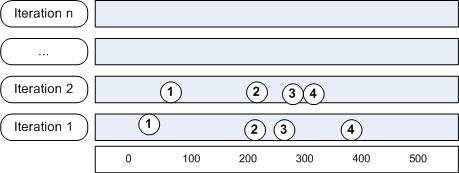Following the example, the following kind of diagram can be used for the representation of the different estimates.

A modification of the Delphi technique to include more estimation team interaction. It was described by Barry Boehm in his famous "Software Engineering Economics" book (1981).
The estimation problem is defined and the participants are selected during planning. The kickoff meeting introduces the problem to the estimators. Each participant then individually prepares his or her initial task lists and estimates. They bring these items to the estimation meeting, during which several estimating cycles lead to a more comprehensive task list and a revised set of estimates. The moderator or project manager then consolidates the assorted estimation information, and the team reviews the estimation results. When some predetermined exit criteria are satisfied, the process is completed.
What follows is a script for an activity of collaborative estimation using the wideband Delphi technique. A proposed problem is provided as an application case, but other may be used instead.
Problem specification example: Warehouse management software portfolio.
The problem statement is contained in pages 19 to 37 of the following report
available through the Web:
http://www.lrgl.uqam.ca/cosmic-ffp/casestudies/fetcke1999b.pdf
Following the example, the following roles are assigned: a developer, two software managers and a member
of the quality assurance staff.
Following the example, a synchronous Yahoo messenger session is conducted. Some Web resources explaining
the principles of the Delphi method are provided. A PDF file
with the problem specification was distributed some days before the meeting, and a discussion is held
to gain a shared understanding of the problem. The session history is recorded for eventual analysis.
Following the example, the estimators work during two days in their initial estimates. The
following Table template is given to them:
Task
Estimate (days of effort)
Comments
...
...
...
...
...
...
...
...
...
Total
...
...
Following the example, the following kind of diagram can be used for the representation of the
different estimates.

Following the example, additional columns can be used to record the history of estimations
for each participant:
Task
Estimate (initial)
Estimate (#2)
Estimate (#3)
...
Comments (last estimate)
...
...
...
...
...
...
...
...
...
...
...
...
Total
...
...
...
...
...